Both you and your betta will appreciate a well-planted fish tank. You, for the aesthetic appeal, and your pet fish for the water quality boosting aspects and enriching environment.
Although fake plants, particularly silk plants, are a great option and have the benefit of not needing plant maintenance, live freshwater plants are the optimal choice.
When deciding upon a plant, consider your lighting levels, substrate, size of the tank, and what fish you have.
Do you want a slow grower? Do you want dense vegetation or plants to cover your aquarium floor?
With so many to choose from, it’s hard to know which are the best plants for betta fish.
Here’s a comprehensive list of plants to use in your betta tank!
#1 African Onion Plant (Crinum Calamistratum)

For those betta fish tank owners with larger tanks, the African Onion plant is a unique-looking yet easy-to-grow plant.
The African Onion Plant can grow up to 4 feet long in its natural environment so it will require trimming.
The stalks reach out in different directions, so this plant needs a lot of room.
This plant thrives in a fine gravel or soil substrate but not sand. If you’re using gravel here’s our article on the best plants that grow in gravel.
Crinum calamistratum is known for its onion-like appearance and impressive size.
Its unique foliage makes it a popular choice among aquarists.
| Common Name | African Onion Plant |
| Scientific Name | Crinum Calamistratum |
| Origin | Africa |
| Ease of Care | Easy to moderate |
| Placement in tank | Background |
| Substrate | Fine gravel or soil |
| Height | 36-48” inches (91-122cm) |
| pH | 6.1-7.9 |
| Water Hardness | 0-18 dH |
| Temperature | 68-82°F |
| Growth Rate | Slow |
| Propagation | Bulb shoots |
| Light | Medium |
| Fertilizer | Low CO2 (Carbon Dioxide) |
#2 African Water Fern (Bolbitis Heudelotii)

This slow-growing plant is popular due to its vivid light-to-dark green color. It has broad leaves and is easy for beginner aquarists.
The recommended tank size is 20 gallons minimum (which your betta will love!), and this plant prefers a gentle water flow.
With its easy care skill level and ability to enhance the overall aesthetics of aquatic environments, the African water fern is a valued addition to any planted tank.
| Common Name | African Water Fern |
| Scientific Name | Bolbitis heudelotii |
| Origin | West Africa |
| Ease of Care | Minimal to moderate care |
| Placement in tank | Midground or background |
| Substrate | Rocky or sandy, driftwood |
| Height | 16-22” inches |
| pH | 6.0-7.5 |
| Water Hardness | 5-15 dGH |
| Temperature | 74-84°F |
| Growth Rate | Slow |
| Propagation | Rhizome |
| Light | Moderate |
| Fertilizer | Fertilizers and CO2 |
#3 Amazon Sword (Echinodorus Spp.)
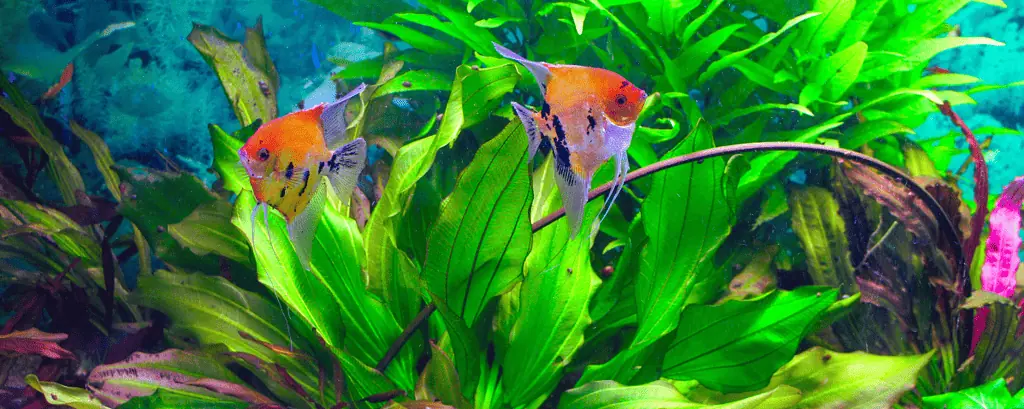
Betta fish love this very popular plant with bright green leaves tapering to a point.
The Amazon Sword plant is highly valued for its attractive appearance, and these plants are easy to care for with an ability to enhance aquariums’ visual appeal.
It’s one of the best plants for a betta fish and a popular choice from beginner to advanced aquarists, providing freshwater tanks with a vibrant and natural look.
| Common Name | Amazon Sword |
| Scientific Name | Echinodorus spp |
| Origin | Amazon River Basin |
| Ease of Care | Low maintenance |
| Placement in tank | Middle or background |
| Substrate | 3-4” inches deep |
| Height | 14-16” inches |
| pH | 6.5-7.5 |
| Water Hardness | 2-12 dGH |
| Temperature | 60°-82.5° F |
| Growth Rate | Moderate to fast |
| Propagation | Cutting plantlets |
| Light | Medium to bright |
| Fertilizer | Yes; iron booster if yellow or brown leaves |
#4 Anacharis (Egeria Densa)
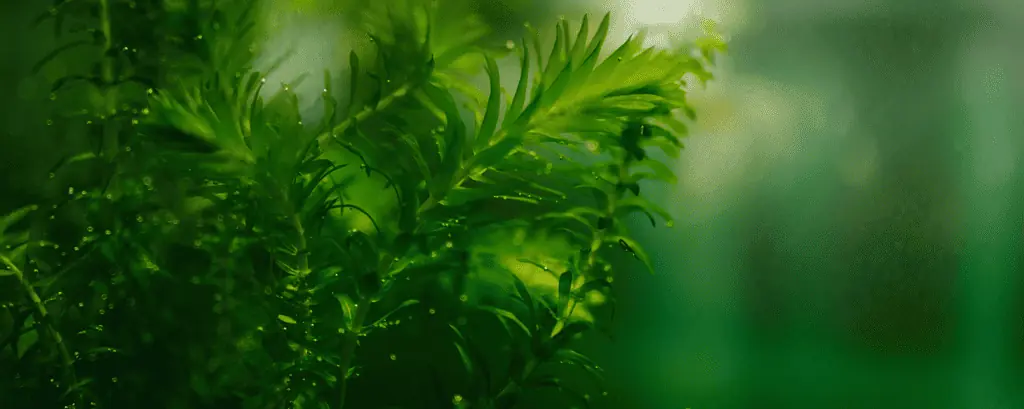
This plant is beloved for its bright green, lush leaves and long, deep green stem.
It is a favorite of beginners as it is easy to maintain.
A ten- or twenty-gallon tank is sufficient as good light levels are maintained.
It is considered to be one of the hardest aquarium plants out there.
Anacharis plants are valued for their rapid growth, oxygenating properties, and ability to create a lush and natural appearance in planted betta tanks and water gardens.
| Common Name | Anacharis |
| Scientific Name | Egeria densa |
| Origin | South America |
| Ease of Care | Easy |
| Placement in tank | Background |
| Substrate | Aquarium gravel or floating |
| Height | Up to 10 feet tall! |
| pH | 6.0-8.0 |
| Water Hardness | 2-20 GH |
| Temperature | 68 – 75°F |
| Growth Rate | Rapid |
| Propagation | 5” Cuttings from stem |
| Light | Moderate to high |
| Fertilizer | Not needed |
#5 Anubias (Anubias Spp.)
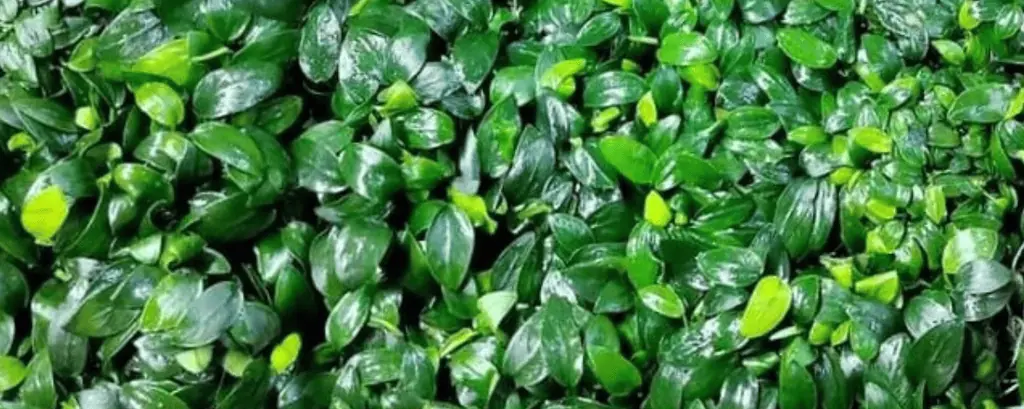
This is a hardy plant with long-lasting green leaves and one of the best live plants for betta fish owners. Anubias are versatile; they are attractive in the fore, mid, or background of the aquarium.
This plant requires a minimum depth of 12 inches of water.
Anubias plants are valued for their durability, versatility, and ability to thrive in various aquatic environments.
Their beautiful foliage and low-maintenance nature make them a popular choice for betta tanks and community tanks.
| Common Name | Anubias |
| Scientific Name | Anubias spp |
| Origin | Africa |
| Ease of Care | Easy |
| Placement in tank | Fore-, mid- or background |
| Substrate | Not necessary |
| Height | 3.9”-5.4” inches |
| pH | 6.5-7.8 |
| Water Hardness | 2-15 dGH |
| Temperature | 72°-78° F |
| Growth Rate | Slow; 2-6 leaves per year |
| Propagation | Rhizomes |
| Light | Low to moderate |
| Fertilizer | CO2 not required but beneficial |
#6 Baby Leaf Fern (Bolbitis Difformis)
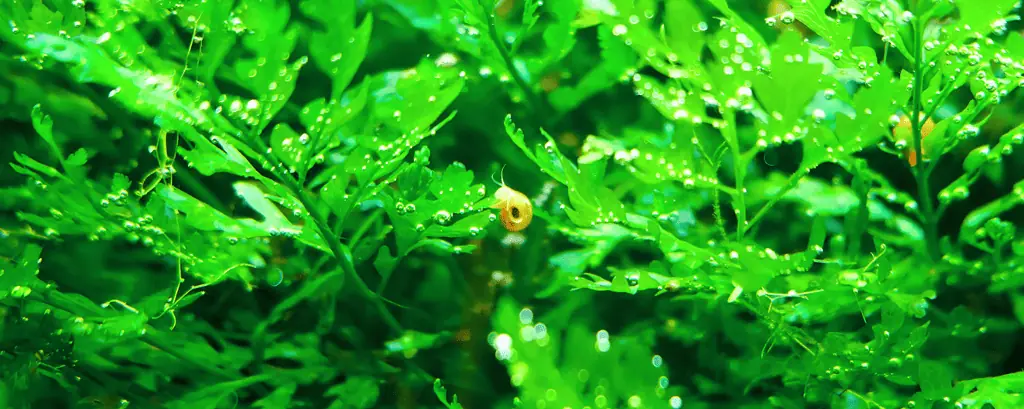
A miniature aquatic fern, a baby leaf fern grows to look like a carpet in your aquarium.
It enjoys being placed in areas of increased water flow, which helps prevent algae growth.
It is a visually appealing and relatively easy-to-care-for aquatic fern.
Its fine, feathery foliage adds an elegant touch, creating a natural and lush environment for many aquatic inhabitants.
| Common Name | Baby Leaf Fern |
| Scientific Name | Bolbitis difformis |
| Origin | Western Africa |
| Ease of Care | Easy |
| Placement in tank | Foreground, it attaches to hardscape |
| Substrate | Do not cover the rhizome, needs good drainage |
| Height | 4” inches |
| pH | 5.5-7.5 |
| Water Hardness | 4-12 dGH |
| Temperature | 68°-80° F |
| Growth Rate | slow |
| Propagation | Rhizome or daughter plants |
| Light | Low to medium |
| Fertilizer | CO2 recommended |
#7 Bacopa (Bacopa Spp.)
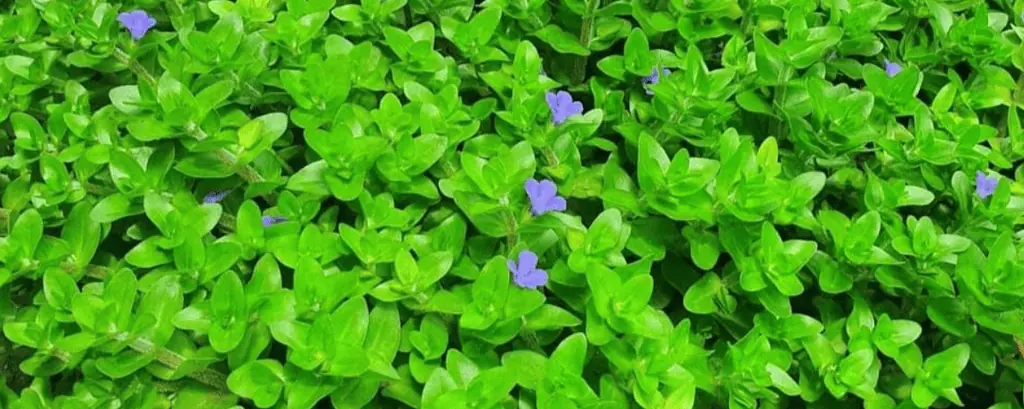
Because this bright green plant grows rapidly and has a thick stem, it is more suited to tall fish tanks.
Using the largest possible aquarium is your best bet, at least a minimum of 15-20 gallons.
Bacopa plant species are popular among aquarists because it’s an easy plant to care for and has the ability to thrive in various conditions.
Bacopa plants are known for growing quickly, making them useful for providing oxygenation, shade, and hiding places for aquatic animals.
| Common Name | Bacopa |
| Scientific Name | Bacopa spp |
| Origin | Southern United States |
| Ease of Care | Moderate |
| Placement in tank | Background or floating |
| Substrate | Anchored in a sandy, gravelly or pebbly substrate, or floating |
| Height | Up to 10” inches |
| pH | 6.0-8.0 |
| Water Hardness | 8-20 dGH |
| Temperature | 60°-82° F |
| Growth Rate | Fast |
| Propagation | New shoots and cuttings |
| Light | Low to moderate |
| Fertilizer | Recommended, liquid |
#8 Banana Plant (Nymphoides Aquatica)
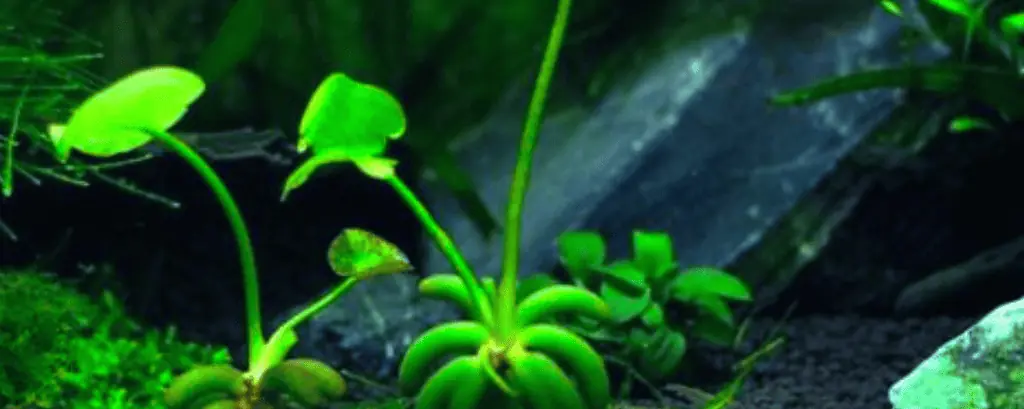
This plant is popular among aquarium hobby enthusiasts due to its attractive appearance and ease of care.
Nymphoides aquatica produces small, delicate white or yellow flowers emerging above the water’s surface on long stalks.
The flowers have a star-like shape with five petals and a yellow center.
| Common Name | Banana Plant. Banana Lily |
| Scientific Name | Nymphoides aquatica |
| Origin | North America |
| Ease of Care | Easy |
| Placement in tank | Foreground |
| Substrate | Sand, gravel or soil |
| Height | 2”-12” inches depending on conditions |
| pH | 6.0-7.2 |
| Water Hardness | 5-12 dGH |
| Temperature | 68°-81° F |
| Growth Rate | Medium |
| Propagation | Cuttings |
| Light | Low to high |
| Fertilizer | Depends on the substrate, none for soil |
#9 Betta Bulb (Aponogeton)
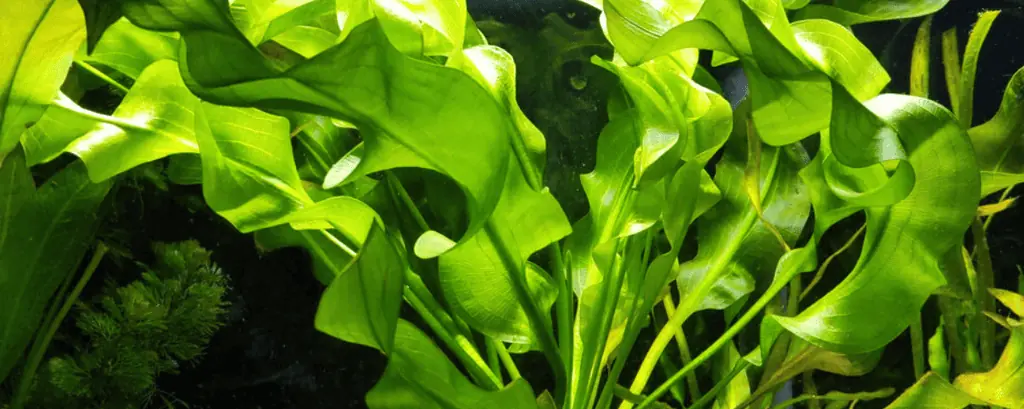
The term “Betta bulb” is commonly used to refer to Aponogeton plants sold as dormant bulbs for betta fish tanks.
These plants have attractive foliage and can produce beautiful flowers.
These “Betta fish plants” can thrive with proper care and attention.
They create an appealing aquatic environment for betta fish and other tank inhabitants.
| Common Name | Betta Bulb |
| Scientific Name | Aponogeton |
| Origin | Africa, Asia, Australasia |
| Ease of Care | Easy |
| Placement in tank | Background |
| Substrate | Aquarium soil |
| Height | Up to 12” inches |
| pH | 6.5-7.5 |
| Water Hardness | Soft to hard |
| Temperature | 68°-75° F |
| Growth Rate | Fast |
| Propagation | Daughter plants |
| Light | Low to medium light, bright for sprouting |
| Fertilizer | Root tabs, capsules if not in soil |
#10 Bladderwort (Utricularia Graminifolia)
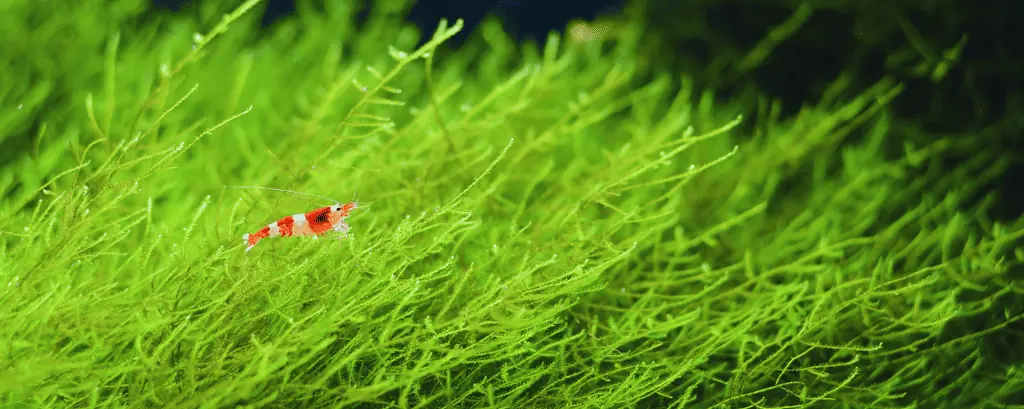
Bladderwort makes an interesting and pretty addition to your tank setup.
Cultivated for its grass-like leaves, it is often planted in the foreground and mid-ground.
Utricularia graminifolia is a fascinating plant known for its carnivorous nature – but your fish are safe! – and aesthetic appeal.
It is a good choice for creating beautiful underwater landscapes.
| Common Name | Bladderwort |
| Scientific Name | Utricularia graminifolia |
| Origin | South America |
| Ease of Care | Moderately difficult |
| Placement in tank | Fore- to mid-ground |
| Substrate | Cutting, separating, and replanting clumps |
| Height | Less than .5” inches |
| pH | 5.0-6.5 |
| Water Hardness | soft |
| Temperature | 64°-77° F |
| Growth Rate | Moderate to fast |
| Propagation | Cutting, separating and replanting clumps |
| Light | Intense |
| Fertilizer | CO2 injection recommended |
#11 Brazilian Pennywort (Hydrocotyle Leucocephala)

Pennywort’s pretty green color adds beauty and superb water conditioning to your tank.
It is an easily grown plant.
Brazilian Pennywort is native to the tropical regions of North, Central, and South America.
It is a popular choice among betta owners and pond keepers.
It has an attractive appearance, is easy to care for, and thrives in various water conditions.
| Common Name | Brazilian Pennywort, Brazilian Water Ivy |
| Scientific Name | Hydrocotyle leucocephala |
| Origin | Brazil |
| Ease of Care | Easy |
| Placement in tank | Background |
| Substrate | Sand, gravel, floating |
| Height | Up to 24” inches |
| pH | 6.0-7.8 |
| Water Hardness | 4-18 dGH |
| Temperature | 68°-82° F |
| Growth Rate | Fast |
| Propagation | Cuttings |
| Light | Variable |
| Fertilizer | None |
#12 Bucephalandra (Bucephalandra Spp.)
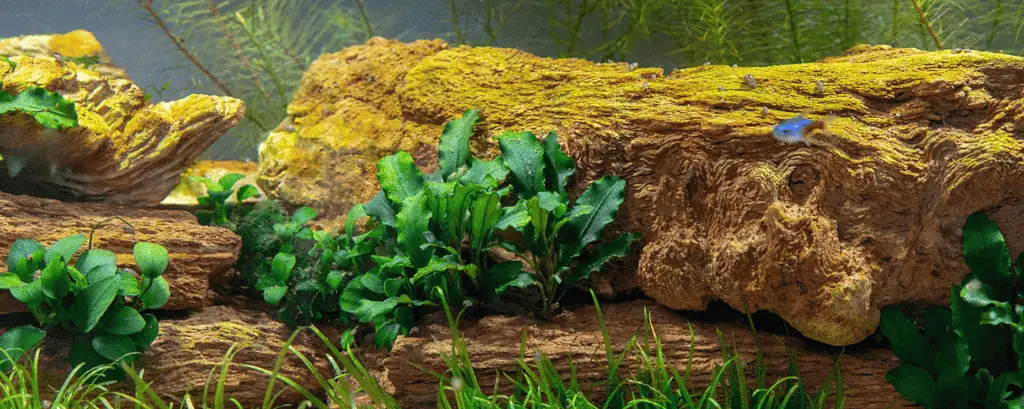
Bucephalandra is a hardy, attractive plant naturally growing in rivers. It needs sufficient water circulation.
Bucephalandra is popular among aquarists for its unique leaf shapes, patterns, and colors.
Its slow growth rate and relative ease of care make it an attractive addition.
| Common Name | Bucephalandra, Buce plant |
| Scientific Name | Bucephalandra spp. |
| Origin | Borneo |
| Ease of Care | Easy |
| Placement in tank | Foreground |
| Substrate | Best with roots on wood or stones |
| Height | 3” inches |
| pH | 5.0-8.0 |
| Water Hardness | Soft to moderate; 5 dGH and above |
| Temperature | 60°-82° F |
| Growth Rate | slow |
| Propagation | Rhizome cuttings |
| Light | Medium-low |
| Fertilizer | CO2 |
#13 Cabomba (Cabomba Spp.)
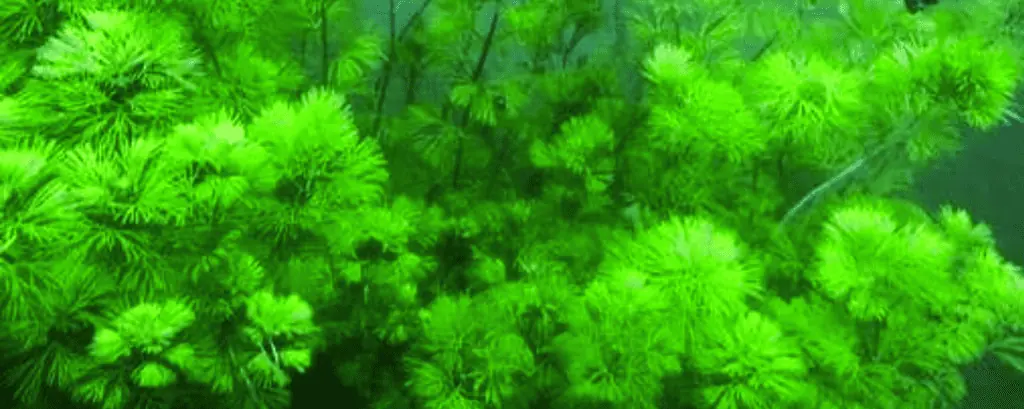
Cabomba is tall, has feathery leaves fanning out from its branches, and provides shelter for inhabitants.
Cabomba adds beauty and natural filtration to freshwater habitats.
Whether in a natural setting or an aquarium, these plants contribute to the overall health and aesthetics of the aquatic environment.
| Common Name | Cabomba |
| Scientific Name | Cabomba spp. |
| Origin | South America |
| Ease of Care | Easy |
| Placement in tank | Background |
| Substrate | Aquarium soil |
| Height | 6”8” inches, but can grow up to 2 feet |
| pH | 6.5-7.5 |
| Water Hardness | 3-8 dGH |
| Temperature | 72°-82° F |
| Growth Rate | Fast |
| Propagation | Cuttings |
| Light | High light, 3 watts per gallon |
| Fertilizer | CO2, root tabs |
#14 Cardinal Plant (Lobelia Cardinalis)

This versatile plant is grown submerged or emersed.
Its bright red coloration (submersed) contrasts beautifully with green foliage.
This provides an attractive focal point for your aquarium.
| Common Name | Cardinal Plant |
| Scientific Name | Lobelia cardinalis |
| Origin | North America |
| Ease of Care | Easy to moderate |
| Placement in tank | Any, depending on height |
| Substrate | Aquarium soil |
| Height | 4-12” inches |
| pH | 6.0-7.0 |
| Water Hardness | 2-12 dGH |
| Temperature | 63°-82° F |
| Growth Rate | Moderate |
| Propagation | Rhizomes |
| Light | Moderate to high |
| Fertilizer | Root tabs, CO2 supplementation |
#15 Christmas Moss (Vesicularia Montagnei)
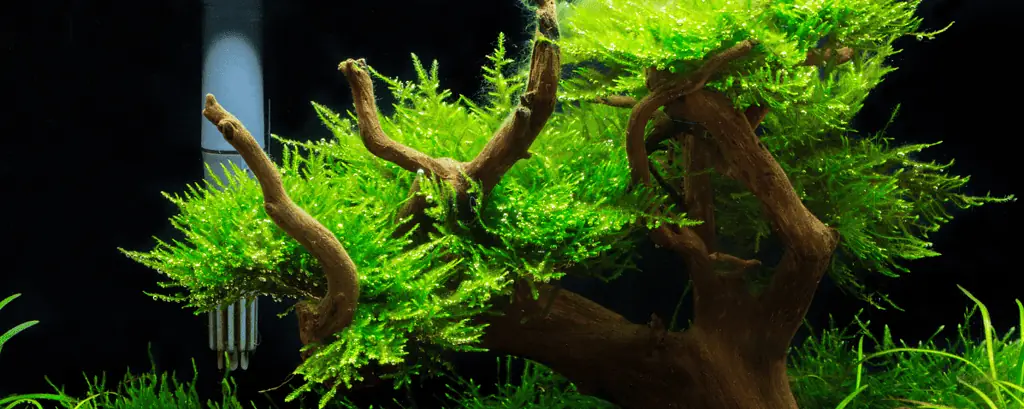
This plant is an aquatic moss and grows submersed in water.
Animals and fish fry use it for hiding spots in the tank. It is often mixed up with Java moss.
Christmas Moss is relatively easy to maintain and adds a touch of natural beauty.
Its unique growth pattern and rich green color make it a popular choice.
| Common Name | Christmas Moss |
| Scientific Name | Vesicularia montagnei |
| Origin | Asia |
| Ease of Care | Easy to medium |
| Placement in tank | In the foreground as a carpet or the background as a wall |
| Substrate | Rocks, branches, floating |
| Height | 4” inches |
| pH | 6.0-7.5 |
| Water Hardness | soft |
| Temperature | 68°-82° F |
| Growth Rate | Slow, depending on light and nutrients |
| Propagation | Division |
| Light | Medium to bright |
| Fertilizer | None, but fertilizer and CO2 will be beneficial |
#16 Creeping Gratiola (Gratiola Viscidula)

Gratiola Viscidula has thorn-like leaves with a bright green color. It is a relative newcomer to aquarists.
In the wild, it is native to the eastern and southern regions of the United States.
It typically grows in wetlands, marshes, and along the edges of ponds and streams.
It’s a nice midground plant in most aquatic settings.
| Common Name | Creeping Gratiola |
| Scientific Name | Gratiola viscidula |
| Origin | North America |
| Ease of Care | Easy |
| Placement in tank | Midground |
| Substrate | Aquarium soil |
| Height | 1”-3” |
| pH | 5.0-7.0 |
| Water Hardness | Wide range of tolerance |
| Temperature | 72°-82° F |
| Growth Rate | Slow |
| Propagation | Cuttings, division |
| Light | Medium to high |
| Fertilizer | Yes, CO2 6-14 mg/L and fertilizer |
#17 Cryptocoryne (Cryptocoryne Spp.)
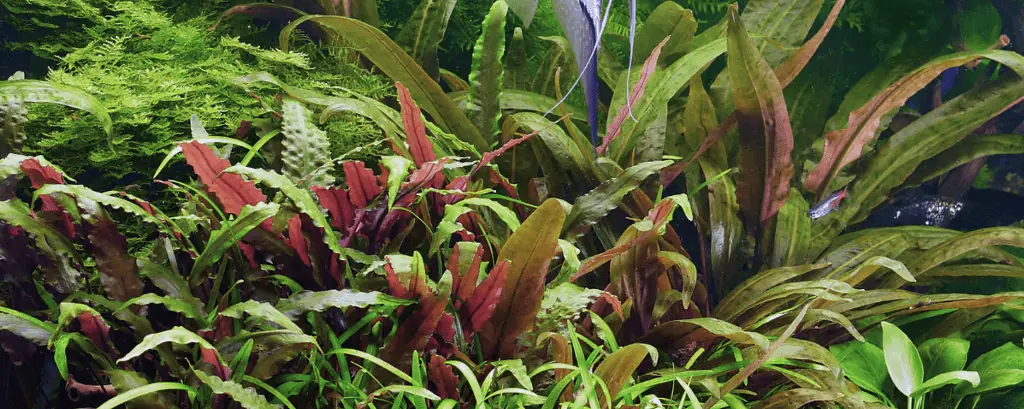
Cryptocoryne, or crypts, have varied leaf shapes, colors, and patterns.
These plants provide a lush and natural look while offering hiding places for fish and other tank mates.
Crypts range from the smaller Cryptocoryne wendtii (4 inches tall) to the large Cryptocoryne crispatula var. balansae (22 inches tall).
| Common Name | Cryptocoryne |
| Scientific Name | Cryptocoryne spp. |
| Origin | Southeastern Asia |
| Ease of Care | Easy |
| Placement in tank | Fore-, mid-, and background |
| Substrate | Soil, gravel, sand, even clay depending on variety, but needs good drainage |
| Height | 4”-22” inches |
| pH | 6.5-7.5 |
| Water Hardness | Moderate to hard |
| Temperature | 72°-80° F |
| Growth Rate | Slow |
| Propagation | Runners, division |
| Light | Medium to bright |
| Fertilizer | Liquid fertilizer every other month, or root tabs if not in soil |
#18 Crystalwort (Riccia Fluitans)
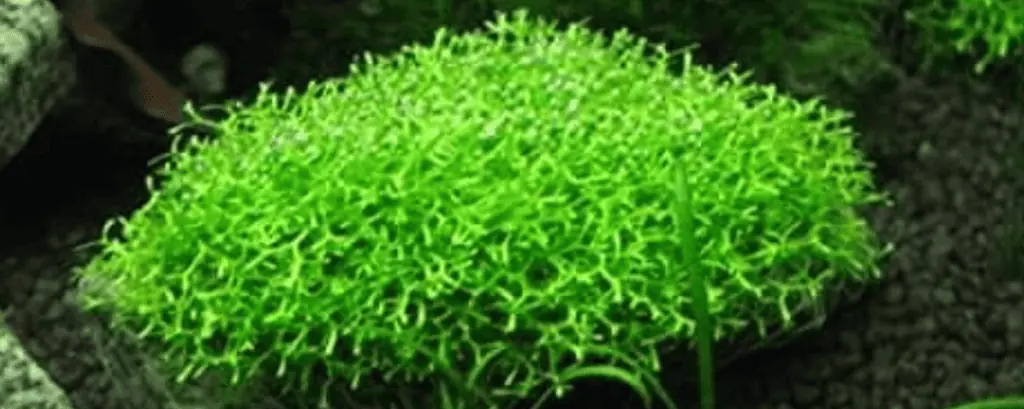
Crystalwort looks mossy but is not a true moss. It is part of the Liverwort genus.
Crystalwort is native to regions with temperate and tropical climates worldwide, including Asia, Africa, Europe, and North America.
The Japanese variety is the one grown fully submerged.
It has a delicate appearance, propagates easily, and is highly adaptable.
| Common Name | Crystalwort |
| Scientific Name | Riccia fluitans |
| Origin | Japan, for the submersible kind |
| Ease of Care | Easy |
| Placement in tank | Spores, as plants grow outward |
| Substrate | Floating |
| Height | 1” inch |
| pH | 6.0-8.0 |
| Water Hardness | Wide range from soft to very hard |
| Temperature | 59°-86° |
| Growth Rate | Rapid |
| Propagation | Medium depends on placement |
| Light | Medium depends on the placement |
| Fertilizer | None specifically |
#19 Downoi (Pogostemon Helferi)

Downoi has a rosette-shaped look with a wavy leaf shape. It makes an attractive foreground plant.
It has compact growth, vibrant green coloration, and textured leaves.
Downoi is a rewarding aquatic plant to grow.
| Common Name | Downoi |
| Scientific Name | Pogostemon helferi |
| Origin | Southeast Asia |
| Ease of Care | Medium to hard |
| Placement in tank | Foreground |
| Substrate | CO2 recommended, root tab |
| Height | 2”-6” inches |
| pH | 6.0-8.0 |
| Water Hardness | Moderately hard |
| Temperature | 68°-86° F |
| Growth Rate | Fast |
| Propagation | Cuttings |
| Light | Medium to bright |
| Fertilizer | CO2 recommended root tab |
#20 Duckweed (Lemna Minor)
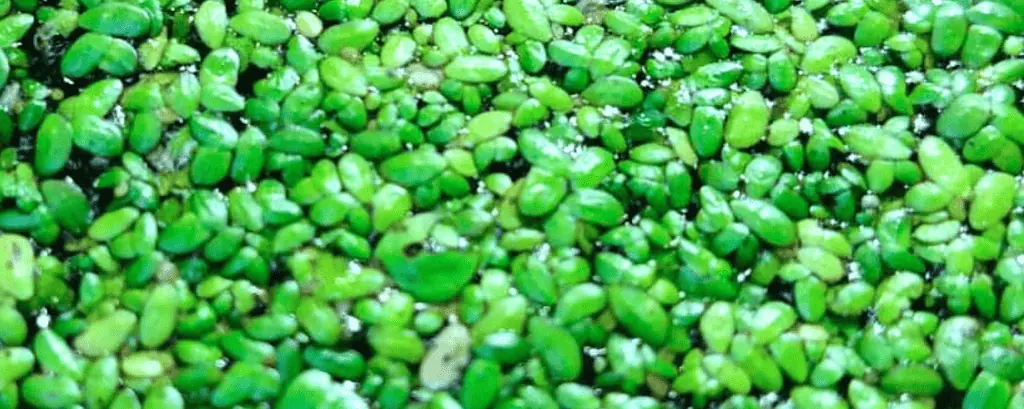
Duckweed’s small size and rapid growth rate make it an excellent addition to tanks with small inhabitants. Shrimp, snails, and fry eat it and shelter in its cover.
Duckweed must be maintained, or it will take over your tank’s surface.
Betta fish enjoy eating duckweed and will help keep it in check.
| Common Name | Duckweed |
| Scientific Name | Lemna minor |
| Origin | Throughout world |
| Ease of Care | Needs frequent trimming |
| Placement in tank | Floating |
| Substrate | Floating on surface |
| Height | 0.2”-0.3” inches in diameter |
| pH | 6.0-8.0 |
| Water Hardness | 2-15 GH |
| Temperature | 68°-82° F |
| Growth Rate | Fast |
| Propagation | Daughter fronds, basically cloning itself |
| Light | Moderate |
| Fertilizer | Needs oxygenated water |
#21 Dwarf Sagittaria (Sagittaria Subulata)
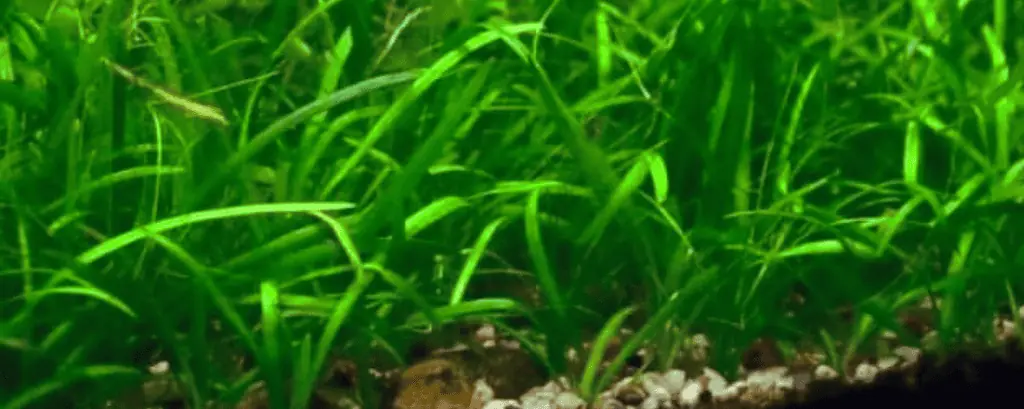
Dwarf Sagittaria makes a hardy, grassy-looking foreground plant. It’s an easy plant to grow and undemanding.
It is known for its grass-like appearance, long narrow leaves, and ability to form dense carpets in aquariums.
Dwarf Sagittaria is one of the best live plant choices for beginner aquarists.
| Common Name | Dwarf Sagittaria |
| Scientific Name | Sagittaria subulata |
| Origin | Eastern USA and South America |
| Ease of Care | Easy |
| Placement in tank | Foreground or midground |
| Substrate | Nutrient-rich soil |
| Height | 4-6” inches |
| pH | 6.0-8.0 |
| Water Hardness | Soft to hard |
| Temperature | 68°-82° F |
| Growth Rate | Fast |
| Propagation | Runners |
| Light | Medium |
| Fertilizer | If not planted in soil, give root tabs as a supplement |
#23 Frogbit (Limnobium Laevigatum)
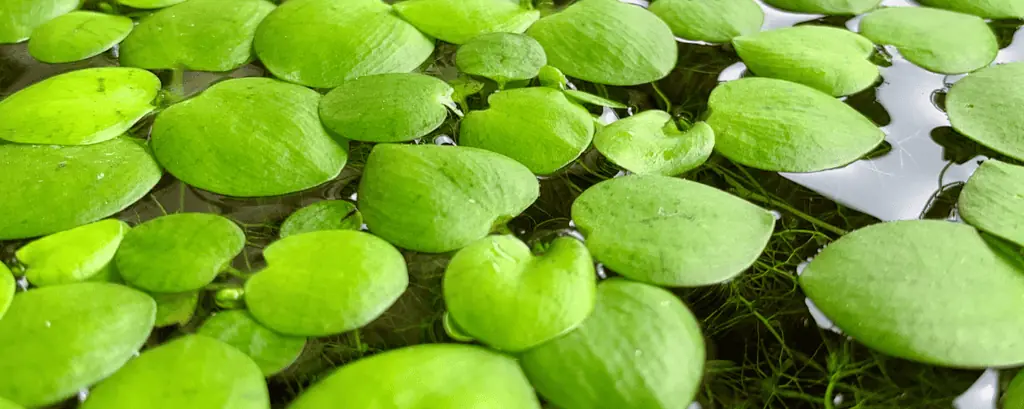
Frogbit is a hardy, non-picky floating plant to grow in your betta aquarium.
It has heart-shaped leaves and long roots, floats at the top of the tank, and spreads across the water’s surface.
Ensure you trim it back enough so your betta has room for surfacing.
Many species of fish use the frogbit as a breeding plant.
It is a good food source and shelter for fry or smaller fish and invertebrates.
| Common Name | Frogbit |
| Scientific Name | Limnobium laevigatum |
| Origin | South America |
| Ease of Care | Easy |
| Placement in tank | Clay, silt, or sand; attach rocks to roots |
| Substrate | A low level of CO2 is helpful; fertilize every two weeks |
| Height | 4”-8” inches |
| pH | 6.5-7.5 |
| Water Hardness | 0-12 GH |
| Temperature | 68°-82° F |
| Growth Rate | Medium |
| Propagation | Plantlets |
| Light | Bright, indirect |
| Fertilizer | A low level of CO2 is helpful; fertilize every 2 weeks |
#24 Glosso (Glossostigma Elatinoides)
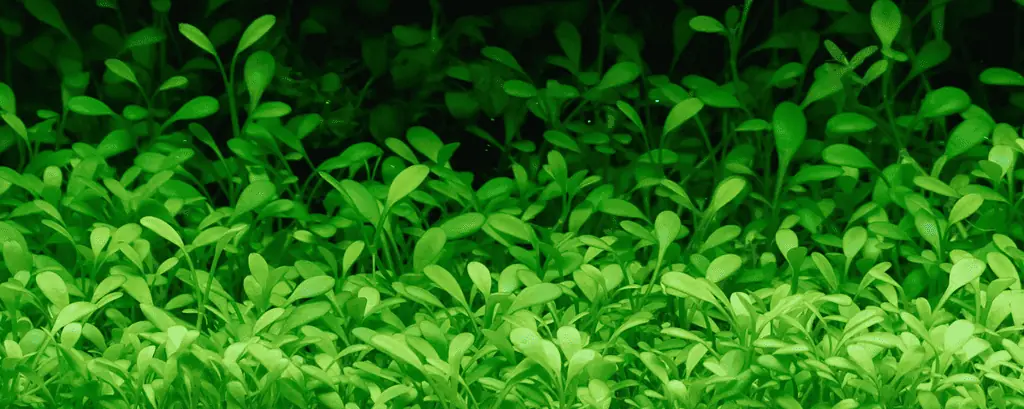
A small trailing plant with green curly branches. Makes a lush carpet on the bottom of the aquarium.
As a carpet-like plant, Glosso will provide hiding places for small invertebrates and fry.
| Common Name | Glossostigma, Glosso |
| Scientific Name | Glossostigma elatinoides |
| Origin | New Zealand |
| Ease of Care | Medium to Difficult |
| Placement in tank | Foreground |
| Substrate | Nutrient-rich, fine-grained |
| Height | 1”-2” inches |
| pH | 6.0-7.5 |
| Water Hardness | Softer but tolerates wide range |
| Temperature | 68°-79° F |
| Growth Rate | Fast |
| Propagation | Cut new growth along with roots |
| Light | Medium to high |
| Fertilizer | CO2 required |
#25 Hornwort (Ceratophyllum Demersum)
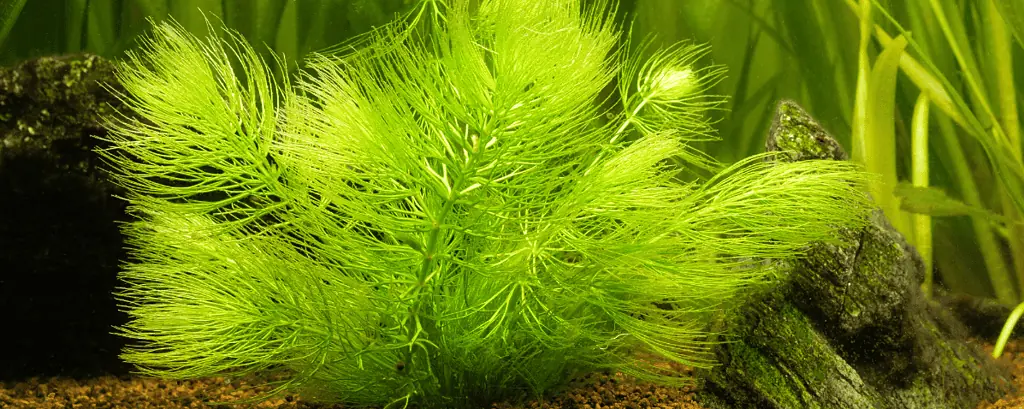
A dark green plant whose bushiness resembles a raccoon’s tail, Hornwort makes an attractive background plant in your aquarium.
Hornwort provides excellent shelter for small fish and fry and is edible for herbivorous fish.
| Common Name | Hornwort, Coontail |
| Scientific Name | Ceratophyllum demersum |
| Origin | North America; worldwide |
| Ease of Care | Easy |
| Placement in tank | Background, floating |
| Substrate | all |
| Height | Up to 24” inches |
| pH | 6.0-7.5 |
| Water Hardness | 5-15 dGH |
| Temperature | 59°-83° F |
| Growth Rate | Rapid |
| Propagation | Spores; stem division |
| Lighting | Low to medium |
| Fertilizer | Yes, it is helpful |
#26 Hygrophila (Hygrophila Spp.)
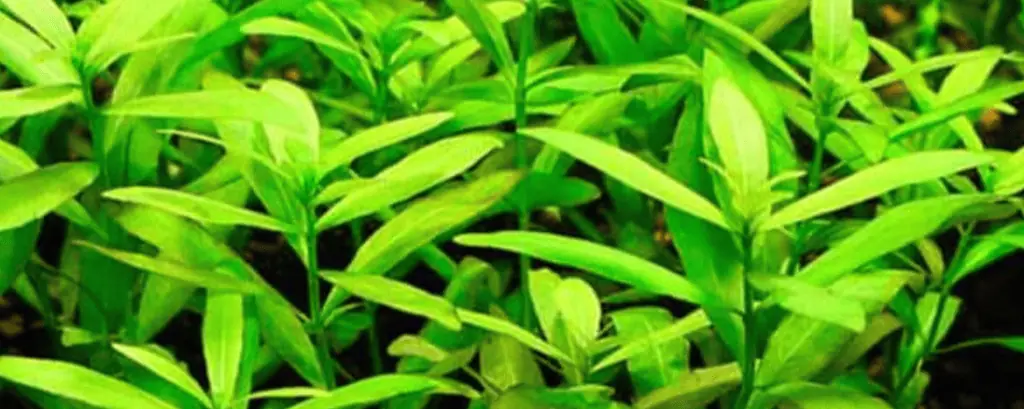
Hygrophila is a genus of plants for betta fish tanks valued for their aesthetic appeal, adaptability, and ease of care.
Their diverse leaf shapes, colors, and growth habits make them great aquarium plants for beginners.
Hygrophila makes an excellent betta fish shelter.
| Common Name | Hygrophila, Swampweeds, Indian Waterweed |
| Scientific Name | Hygrophila spp. |
| Origin | Tropical and subtropical Asia |
| Ease of Care | Easy but needs regular pruning, or it will take over your tank |
| Placement in tank | Background, midground, floating |
| Substrate | Soil, sand, or gravel; needs weighing down |
| Height | Up to 24” inches |
| pH | 5.0-8.0 |
| Water Hardness | Soft to moderately hard |
| Temperature | 64°-86° F |
| Growth Rate | Fast |
| Propagation | Cuttings, even one leaf will grow a new one |
| Lighting | A wide range, the growth rate will increase with higher lighting |
| Fertilizer | CO2 and fertilization helpful |
#27 Japanese Pennywort (Hydrocotyle Tripartita)

Japanese Pennywort’s creeping stems are anchored in the substrate or attached to rocks and driftwood with aquarium-safe glue.
This creates dense mats or walls.
The plant’s compact growth and small leaf size make it ideal for foreground or midground placement in aquariums.
| Common Name | Japanese Pennywort, Japan Clover |
| Scientific Name | Hydrocotyle tripartita |
| Origin | Japan |
| Ease of Care | Intermediate, needs frequent trimming |
| Placement in tank | Foreground, midground, background |
| Substrate | Grow on hardscape, overgrows in nutrient-rich soil |
| Height | 5-10” inches |
| pH | 6.0-7.5 |
| Water Hardness | Soft to moderately hard |
| Temperature | 72°-82° F |
| Growth Rate | Fast |
| Propagation | Cut stem and replant; pull apart clumps and split the roots |
| Lighting | Medium |
| Fertilizer | CO2, fertilizer in the water column, root tabs |
#28 Java Fern (Microsorum Pteropus)
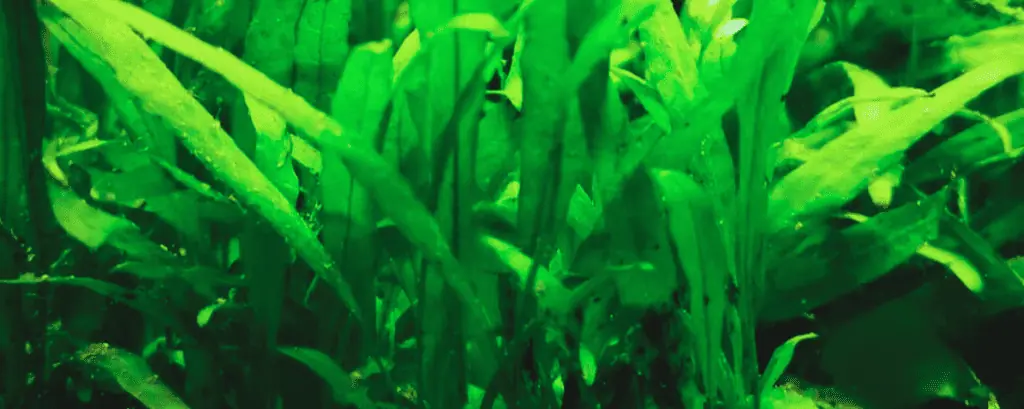
An extremely popular aquarium plant, the Java Fern will add both beauty and functionality to your Betta’s tank.
The Java fern does better dimly lit and not planted deeply.
Its adaptability to various aquarium conditions, low-maintenance requirements, and ability to attach to aquarium decorations make it popular for beginner and advanced aquarists alike.
| Common Name | Java Fern, Narrow Leaf Fern, Needle Leaf Fern, Windelov Fern, Lance Leaf Fern |
| Scientific Name | Java Fern (Microsorum pteropus) |
| Origin | Asia, named after the Indonesian island of Java |
| Ease of Care | Easy |
| Placement in tank | Foreground, midground |
| Substrate | none needed, but fertilizing the water column is beneficial |
| Height | 4”-8” inches |
| pH | 6.0-7.5 |
| Water Hardness | 2-15 dKH |
| Temperature | 68°-82° F |
| Growth Rate | Slow, vulnerable to algae |
| Propagation | Plantlets, rhizome |
| Lighting | Wide range; avoid UV |
| Fertilizer | none needed but fertilizing the water column is beneficial |
#29 Java Moss (Taxiphyllum Barbieri)
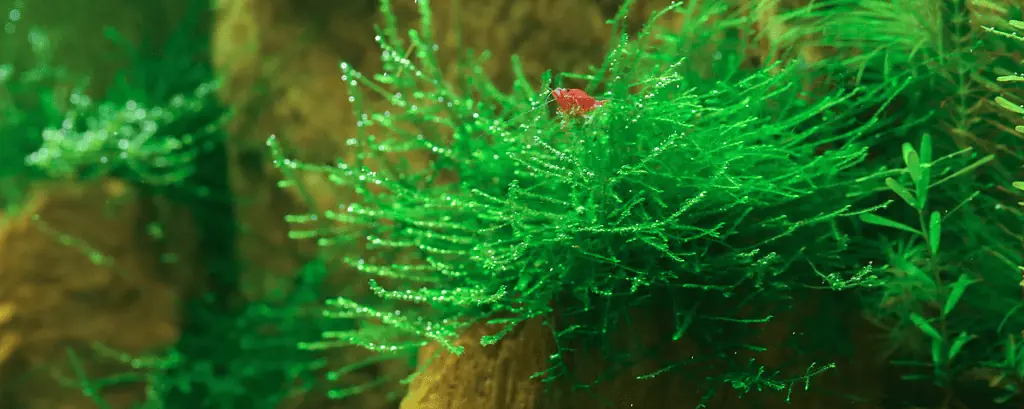
Java Moss is a versatile aquatic plant with green, feathery leaves. It can adapt to various water conditions.
It provides beneficial hiding spots for smaller fish and fry and helps maintain water quality.
It is easy to propagate by division and is a popular choice for beginners and experienced aquarists alike.
| Common Name | Java Moss |
| Scientific Name | Taxiphyllum barbieri |
| Origin | Asia |
| Ease of Care | Easy |
| Placement in tank | As a carpet effect |
| Substrate | Attached to rock, driftwood, or floating |
| Height | Up to 4” inches |
| pH | 6.0-8.0 |
| Water Hardness | 5-10 dGH |
| Temperature | 59°-82° F |
| Growth Rate | Slow to medium |
| Propagation | Through division |
| Lighting | Low to moderate |
| Fertilizer | Low nutrient and low CO2 |
#30 Ludwigia (Ludwigia Spp.)
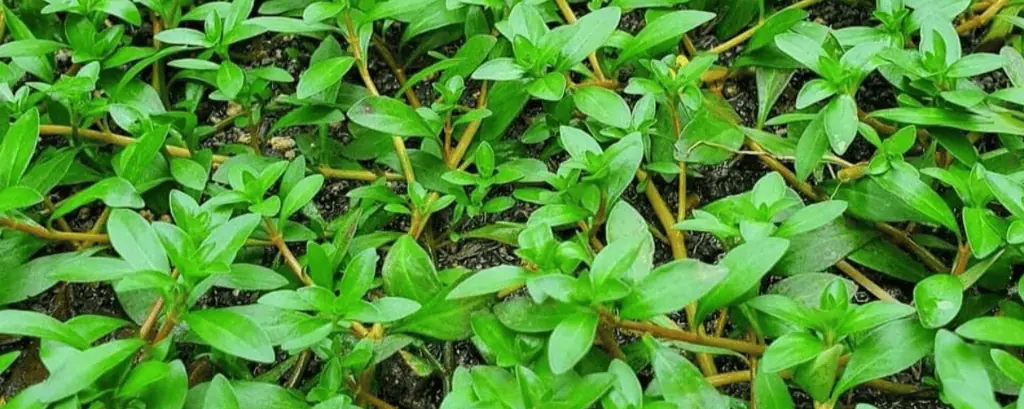
Ludwigia plants have vibrant colors and attractive foliage. They are resilient in various conditions and are moderately easy to grow.
Like many aquatic plants, Ludwigia supplies hiding spots for smaller fish and fry and helps maintain good water parameters.
| Common Name | Ludwigia |
| Scientific Name | Ludwigia spp. |
| Origin | The Americas |
| Ease of Care | Moderate |
| Placement in tank | Midground and background |
| Substrate | Aquarium soil; do not plant in sand |
| Height | 4”-8” inches |
| pH | 6.0-7.0 |
| Water Hardness | 3-8 GH |
| Temperature | 74°-80° F |
| Growth Rate | Fast |
| Propagation | Cuttings |
| Lighting | Medium |
| Fertilizer | Good fertilizer; CO2 not necessary |
#31 Marimo Moss Balls (Aegagropila Linnaei)

Marimo Moss Balls are unique spherical algae resembling moss. They are low-maintenance and adaptable to a variety of water conditions.
These algae balls also create a natural habitat for small fish and invertebrates, providing them shelter and a surface to graze on.
Your betta will enjoy the enrichment but not eat it since bettas are carnivorous.
| Common Name | Marimo Moss Balls, Lake balls, Cladophora balls, Mossimo, Lake ball pets |
| Scientific Name | Aegagropila linnaei |
| Origin | Northern Europe and Japan |
| Ease of Care | Moderate |
| Placement in tank | Foreground, midground, or floating |
| Substrate | Attached or floating |
| Height | 8”-12” inches |
| pH | 7.0-8.0 |
| Water Hardness | Very soft to very hard |
| Temperature | 42°-75° |
| Growth Rate | Slow to moderate |
| Propagation | Splitting and re-rolling them |
| Lighting | Low to moderate |
| Fertilizer | Not needed to low |
#32 Parrot’s Feather (Myriophyllum Aquaticum)
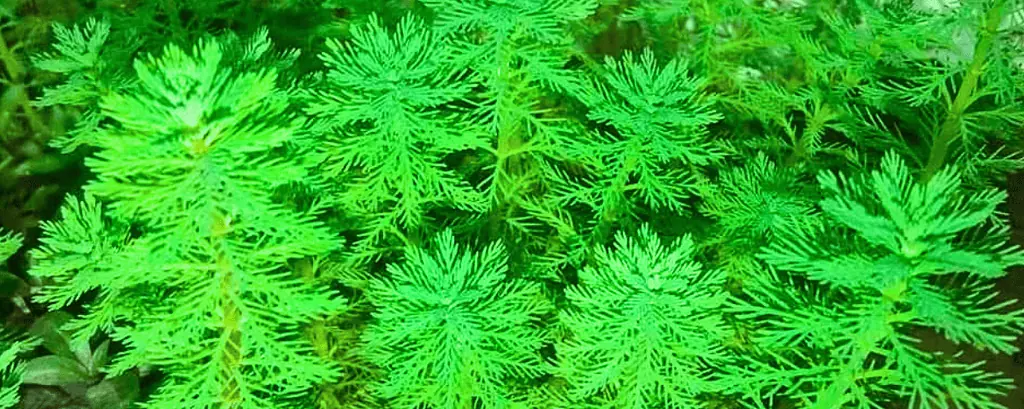
Parrot’s Feather has feathery, fern-like foliage and is very good at oxygenating water. Small fish and fry shelter in it.
Disposing of Parrot Feather properly is important as it is invasive in native waterways.
| Common Name | Parrot’s Feather, Brazilian watermilfoil |
| Scientific Name | Myriophyllum aquaticum |
| Origin | South America |
| Ease of Care | Moderate |
| Placement in tank | Background |
| Substrate | Nutrient rich aquarium soil |
| Height | 4”-16” inches |
| pH | 6.0-7.5 |
| Water Hardness | 3-8 KH |
| Temperature | 60°-86° F |
| Growth Rate | Fast |
| Propagation | Cut stem and replant |
| Lighting | Moderate to high |
| Fertilizer | CO2 recommended |
#33 Pogostemon (Pogostemon Erectus)
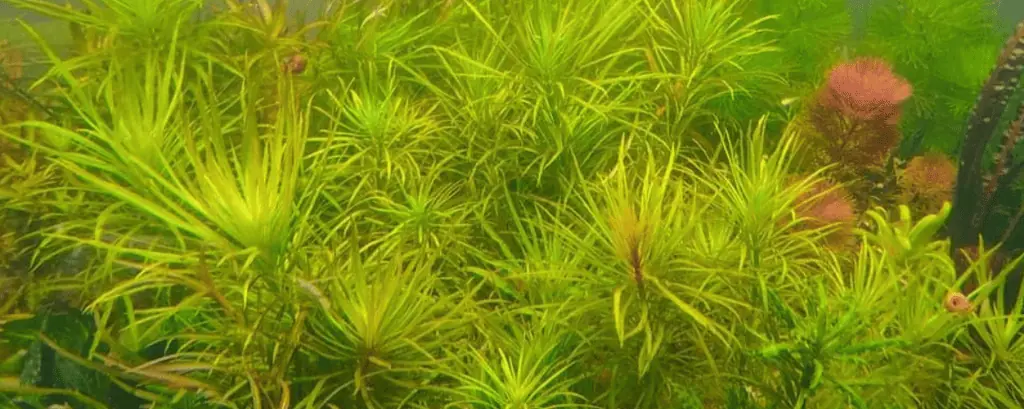
Pogostemon erectus is a unique-looking aquatic plant with needle-like leaves.
It helps oxygenate the water and provides hiding places and grazing surfaces for small fish and invertebrates.
| Common Name | Pogostemon erectus |
| Scientific Name | Pogostemon erectus |
| Origin | Thailand |
| Ease of Care | Medium |
| Placement in tank | Midground or background |
| Substrate | Nutrient rich aquarium soil |
| Height | 2”-3” inches |
| pH | 6.0-7.5 |
| Water Hardness | 1-14 dKH |
| Temperature | 72°-82° F |
| Growth Rate | Moderate |
| Propagation | Cut new growth along with roots |
| Lighting | Medium to high |
| Fertilizer | CO2 and liquid fertilizers |
#34 Pygmy Chain Sword (Helanthium Tenellum)
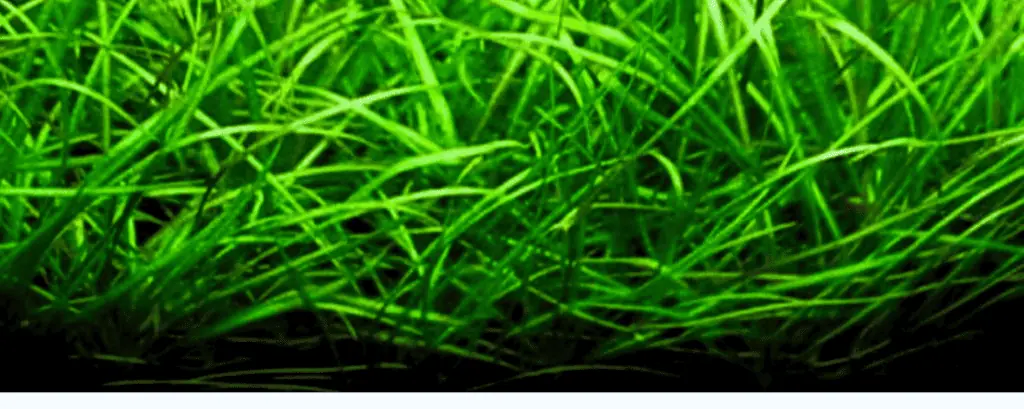
The Pygmy Chain Sword is a compact plant with narrow, grass-like leaves.
This plant is ideal for beginners with its easy care, hardiness, and fast-growing nature.
| Common Name | Pygmy Chain Sword |
| Scientific Name | Helanthium tenellum |
| Origin | The Americas |
| Ease of Care | Medium |
| Placement in tank | Foreground or midground |
| Substrate | Nutrient rich aquarium soil |
| Height | Leaf size about 4” inches |
| pH | 6.5-7.5 |
| Water Hardness | Soft to moderately hard |
| Temperature | 72°F-82° F |
| Growth Rate | Moderate to high |
| Propagation | Runners and plantlets |
| Lighting | Moderate to high |
| Fertilizer | CO2 and fertilizer tabs |
#35 Red Root Floater (Phyllanthus Fluitans)

The plant consists of small, round leaves varying in color from green to reddish-brown.
The undersides of the leaves are often a vibrant red, giving the plant its common name.
As the name implies, Red Root Floater floats on the water’s surface and has reddish brown roots.
You will want to trim this plant back so it doesn’t cover the entire surface of your tank. Your betta needs to be able to surface.
| Common Name | Red Root Floater |
| Scientific Name | Phyllanthus fluitans |
| Origin | South America |
| Ease of Care | Easy |
| Placement in tank | Floating |
| Substrate | Floating |
| Height | Floats on surface |
| pH | 6.0-7.5 |
| Water Hardness | Fertilize the water column, CO2 not necessary |
| Temperature | 72°-82° F |
| Growth Rate | Fast |
| Propagation | Side shoots |
| Lighting | Moderate to high |
| Fertilizer | Fertilize the water column; CO2 not necessary |
#36 Rotala (Rotala Spp.)
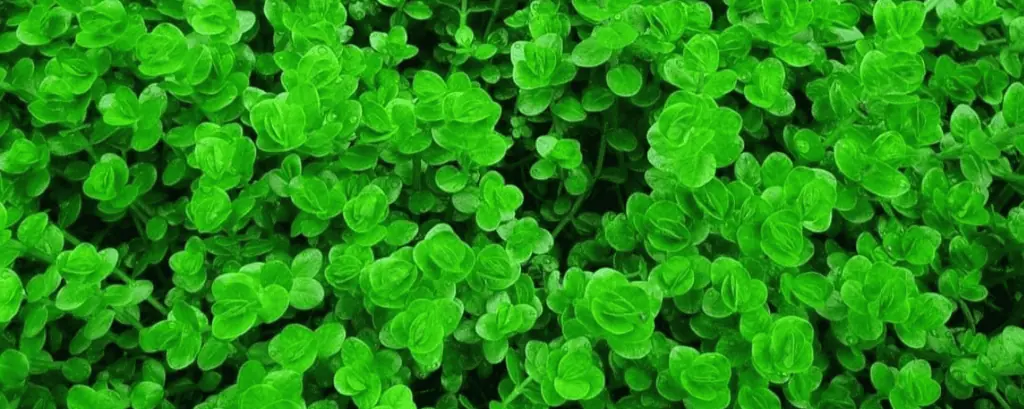
Rotala plants typically have slender stems with densely packed leaves arranged in whorls or spirals along the stem.
This plant can be trimmed to serve in the foreground or midground or left to grow nicely in the background.
| Common Name | Rotala |
| Scientific Name | Rotala spp. |
| Origin | Asia |
| Ease of Care | Difficult |
| Placement in tank | Nutrient-rich aquarium soil |
| Substrate | Nutrient rich aquarium soil |
| Height | 2”-12” inches |
| pH | 6.0-7.5 |
| Water Hardness | Soft to moderately hard |
| Temperature | 72°-82° F |
| Growth Rate | Moderate to fast |
| Propagation | Cut stem and replant |
| Lighting | Moderate to high |
| Fertilizer | Beneficial |
#37 Scarlet Temple (Alternanthera Reineckii)

Scarlet Temple has a striking appearance with its vibrant red or reddish-purple leaves.
The leaves are usually elliptical.
Be careful, and do not have fish who eat plants with your Scarlet Temple; they are delicate plants. Your betta will leave it alone.
| Common Name | Scarlet Temple |
| Scientific Name | Alternanthera reineckii |
| Origin | South America |
| Ease of Care | Moderate |
| Placement in tank | Background, midground |
| Substrate | CO2 is not required but beneficial to growth |
| Height | 10”-20” inches |
| pH | 6.5-7.5 |
| Water Hardness | 6-12 GH |
| Temperature | 72°-82° F |
| Growth Rate | Slow |
| Propagation | Cut the stem and replant |
| Lighting | Medium to high |
| Fertilizer | CO2 is not required but beneficial to the growth |
#38 Stargrass (Heteranthera Zosterifolia)
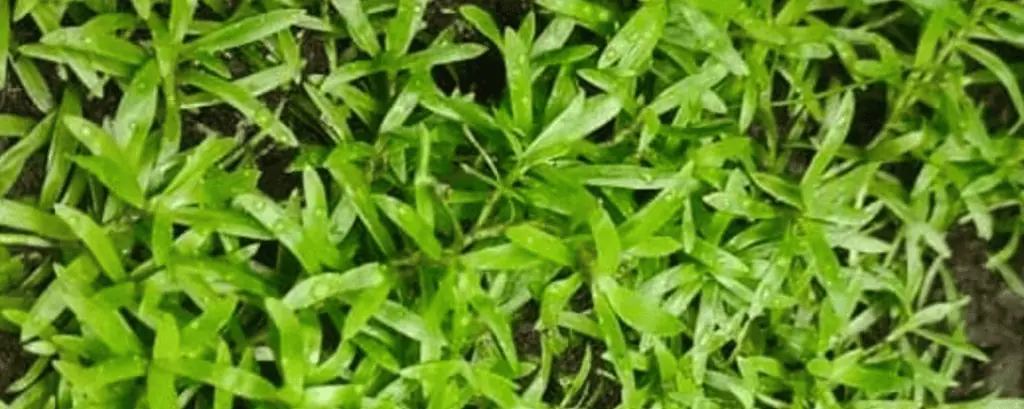
Stargrass is a highly attractive plant due to its delicate and feathery appearance. It has long, thin stems.
Stargrass must be aggressively trimmed to form a carpet-like growth on the bottom of the tank or allowed to grow longer for other placements.
| Common Name | Stargrass |
| Scientific Name | Heteranthera zosterifolia |
| Origin | South America |
| Ease of Care | Medium, need pruning often |
| Placement in tank | Fore-, mid- or background |
| Substrate | Any |
| Height | 10”-20” inches |
| pH | 6.0-7.5 |
| Water Hardness | 1-6 GH |
| Temperature | 68°-79° F |
| Growth Rate | Fast |
| Propagation | Cuttings |
| Lighting | Moderate to bright |
| Fertilizer | CO2 6-14ppm, fertilizer needed |
#39 Staurogyne (Staurogyne Repens)
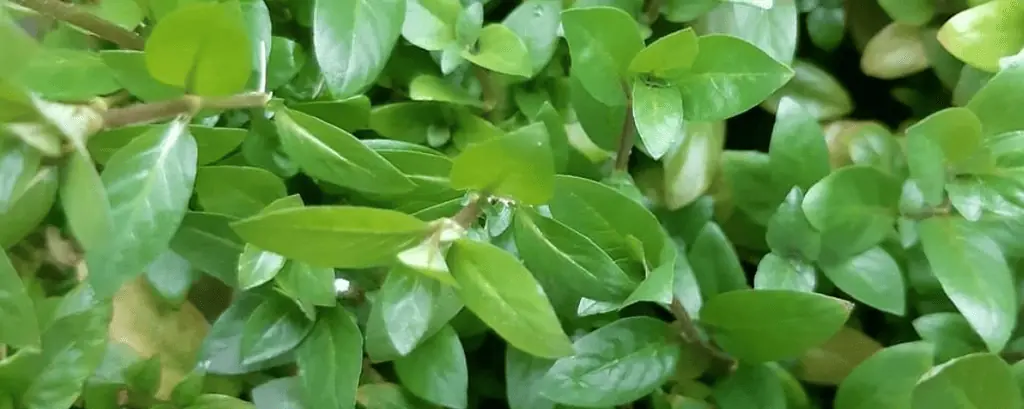
This plant has a bright green color and a bushy appearance. It is hardy and easy to grow.
Like most aquatic plants, Staurogyne improves water quality by removing some of the nitrates and toxins in the water.
| Common Name | Staurogyne |
| Scientific Name | Staurogyne repens |
| Origin | South America |
| Ease of Care | Easy |
| Placement in tank | Fore- or midground |
| Substrate | Any |
| Height | Up to 4” inches |
| pH | 6.0-8.0 |
| Water Hardness | 3-10 KH |
| Temperature | 68°-86° F |
| Growth Rate | Slow |
| Propagation | Side shoots, cutting |
| Lighting | Moderate to high |
| Fertilizer | Liquid fertilizers recommended |
#40 Subwassertang (Lomariopsis Lineata)
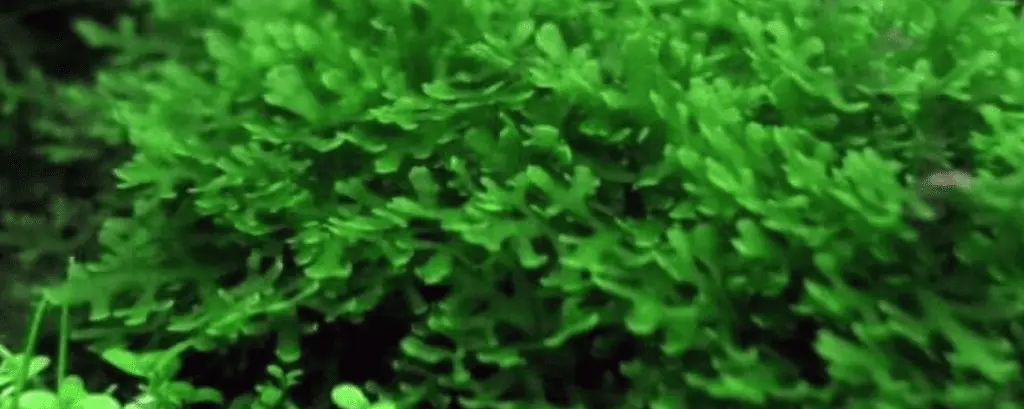
This interesting-looking plant has an attractive round shape with a branching, fern-like structure. It is resilient and easy to propagate.
Subwassertang absorbs excess nutrients and helps maintain water quality.
Small fish and fry, and invertebrates enjoy sheltering in its bushy depths.
| Common Name | Subwasstertang, Round Pellia |
| Scientific Name | Lomariopsis lineata |
| Origin | Southeast Asia |
| Ease of Care | Easy |
| Placement in tank | Foreground and midground |
| Substrate | CO2 is not necessary, fertilizer yes |
| Height | 0.8”-2” inches |
| pH | 6.0-8.0 |
| Water Hardness | Soft to moderately hard |
| Temperature | 68° – 70° F |
| Growth Rate | Slow, appx. 4 inches a year |
| Propagation | Division |
| Lighting | Low to moderate |
| Fertilizer | CO2 is not necessary; fertilizer yes |
#41 Vallisneria (Vallisneria Spp.)
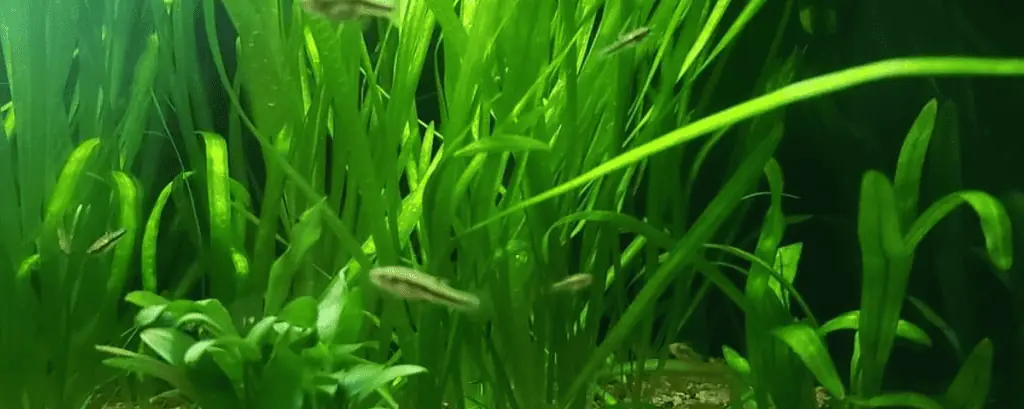
This plant has long, grasslike leaves, hence its common names, tape grass, and eelgrass.
But this plant also has sharp edges on its leaves, so be careful handling them.
Vallisneria grows quickly, particularly with CO2 injections, so be prepared to thin it and keep it from shading other plants too much.
| Common Name | Vallisneria, tape grass, eelgrass, vallis |
| Scientific Name | Vallisneria spp. |
| Origin | Asia, Africa, and North America |
| Ease of Care | Easy |
| Placement in tank | Background |
| Substrate | Loose and not compact |
| Height | 8” to 24” inches |
| pH | 5.0-7.5 |
| Water Hardness | 4-18 GH |
| Temperature | 75°-85° F |
| Growth Rate | Fast |
| Propagation | Runners |
| Lighting | Moderate to high |
| Fertilizer | CO2 is not necessary; regular fertilization |
#42 Wavy-Edged Sword Plant (Aponogeton Ulvaceus)
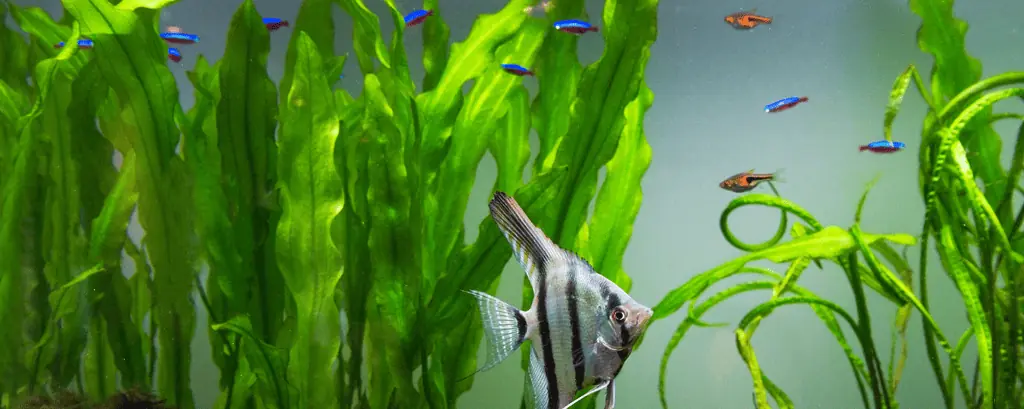
This plant has elongated, narrow, and wavy-edged leaves, giving it its common name of Sword Plant. The leaves are usually a light green or reddish brown, depending on the amount of aquarium light the plant gets.
| Common Name | Nutrient-rich |
| Scientific Name | Aponogeton ulvaceus |
| Origin | Sri Lanka |
| Ease of Care | Easy |
| Placement in tank | Background, midground |
| Substrate | Nutrient rich |
| Height | Up to 24” inches |
| pH | 6.0-8.0 |
| Water Hardness | Softer |
| Temperature | 72°-82° F |
| Growth Rate | Medium |
| Propagation | Rhizome, seeds |
| Lighting | Low to medium |
| Fertilizer | Yes |
#43 Water Sprite (Ceratopteris Thalictroides)

This plant’s bright green leaves resemble the shape of a delicate fern or lace.
It is well-known for improving aquarium water quality and being a good plant for beginners.
Water Sprite is a good plant to monitor the health of your aquarium as it is sensitive to water quality.
| Common Name | Water Sprite, Water Sprite, Indian Water Fern, Water Fern, Oriental Water Fern, Water Horn Fern |
| Scientific Name | Ceratopteris thalictroides |
| Origin | Tropical and subtropical regions |
| Ease of Care | Easy |
| Placement in tank | Fore- or midground, floating |
| Substrate | Nutrient rich |
| Height | Up to 12’ inches |
| pH | 5.0-7.5 |
| Water Hardness | Any |
| Temperature | 68° – 82° F |
| Growth Rate | Fast |
| Propagation | Daughter plants |
| Lighting | Bright |
| Fertilizer | Liquid fertilizer |
Getting Back To Your Roots!
There are so many live plants for your betta to choose from; it’s a wonder we have room to put in a small betta!
Your betta will love any of these plants, especially the ones providing nooks and crannies for your fish to hide in or broad leaves to rest on like a betta hammock.
Live aquatic plants are much better, environmentally and aesthetically, than plastic plants.
Any Betta fish tank will be much improved by adding some plants obtained online or at pet stores.
With proper care, plants on this list can thrive and create a more natural environment for your fish.
Your aquarium will be lush and green with appropriate light conditions, fertilizer, root tabs, and the occasional CO2 injection.
For more about aquarium plants, visit our plant tips category.
If you liked this article on the best betta fish plants, please share it on social media!


